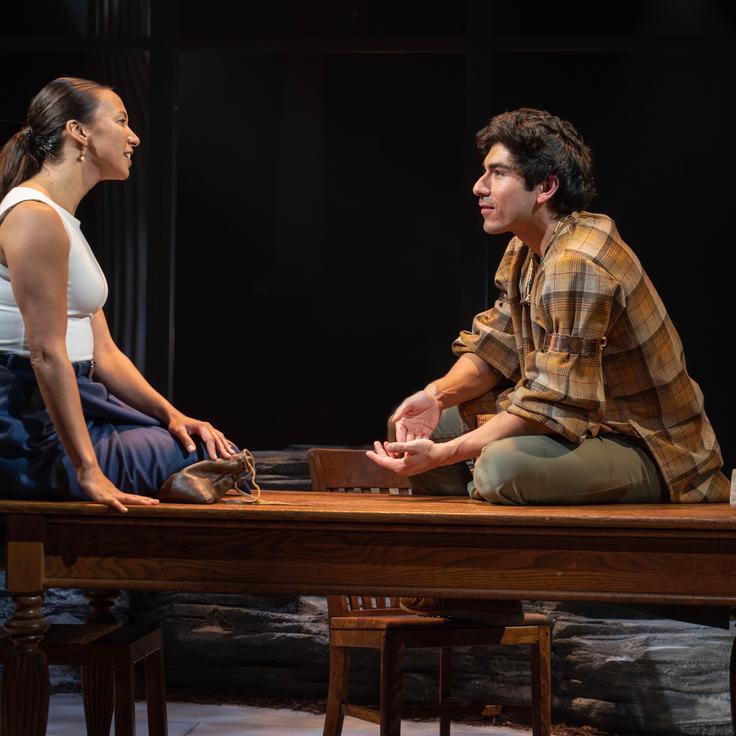If you walk through Battery Park in lower Manhattan, you will find the Netherland Monument — a 1926 piece by the Dutch sculptor Hendrik van den Eijnde, and one of the many structures in New York that perpetuate the myth of the sale of this island. In all his glory, you can see Dutch colonial governor Peter Minuit “purchasing” the land with wampum beads, worth a staggering sum of $24, from a “Lenape Native” whose name no one seems to know. This Native man is wearing a headdress of the sort typically worn by Plains Natives hundreds of miles away. One doesn’t get the sense that van den Eijnde tormented himself trying to get the details right.
The only proof of the “sale” of Manhattan is a small section in a letter written by a colonist in 1626. There’s no mention of beads or trinkets, and no deed of sale, only a passage cited from the Dutch National Archives that reads: “Our people are in good spirit and they live in peace. They have purchased the island of Manhattes from the savages for the value of sixty guilders.”
The problem here is that Lenape peoples, along with most Indigenous peoples, are inextricably connected to the land as stewards, and did not share the concepts of money or land ownership as Europeans did. And so they were strategically displaced from their ancestral homelands, despite having shown graciousness to the Shouwunnok, otherwise known as salt water (read: white) people.
This displacement of the Lenape peoples was a huge motivation for Mary Kathryn Nagle’s play “Manahatta,” which tells the story of Jane Snake, a Lenape woman who moves to Manahatta from Oklahoma during the 2008 financial crisis for a banking job — thus reconnecting with her ancestral homeland. “When I go back to our lands, there’s a connection there that you feel ― it’s inside you. I only feel it when I step on those lands,” Nagle tells me, about her inspiration for Jane’s character, who embodies the playwright’s connection to her own ancestral Cherokee homelands.
As an Indigenous woman, there is a deep-rooted blood memory I feel when I set foot on my ancestral homelands in the Alberta Plains. There is an ancestral connection when I bend down to pick my sage from the earth and place my tobacco as offering. The connection that Indigenous people feel for our ancestral homelands is sacred, and it exists deep within our bones. For Nagle, this emerges in the way Jane moves through the world.
Western Christian ideologies place humans at the center of the universe. By contrast, Lenape beliefs hold that humans grew directly from the earth itself, tethering us to the land. The earth is our original ancestor to care, love, respect and tend to.
These differences of Western and Indigenous ideologies are often expressed in our traditions of storytelling. Nagle explains what these differences mean for the role of the playwright. In American theater, the playwright is placed on a pedestal. We hear about the genius of Arthur Miller, the genius of Shakespeare. But for most Indigenous writers, storytelling is about our connection to community and our ancestors.
“What we’re doing here is a very communal form of storytelling,” Nagle says. “The playwright is a vessel that the story comes through — but it’s not really about the playwright.” Writing is a way for Nagle to connect with her lineage, history, and ancestors. Sometimes, she says, she doesn’t even remember writing down a scene or idea, but she feels as if it comes from ancestral memory: “I do believe the ancestors speak through us, if you allow them to, and if you’re open to that.”
Communal storytelling and discourse is a multigenerational tradition because we are never severed from our lineages, even when we have been forcibly separated from our lands and families. Nagle brings this sentiment to her most recent production of “Manahatta,” which premieres Nov. 16 in New York. And if it takes a village to tell a story, Nagle gathered hers intentionally: Joe Baker serves as a Lenape cultural consultant; movement director Ty Defoe crafted the cultural nonverbal language; and Indigenous and non-Indigenous actors alike contributed perspectives that have created a vibrant and diverse iteration of “Manahatta.”
“That’s how [we] learn and grow — that’s where the magic lies,” says Rainbow Dickerson, who plays Debra, Jane’s older sister. “Yes, it’s nice having a shorthand with people who are similar to you, but to me, beauty lies in the differences.”
Jane’s story emphasizes the struggle of reconciling a new city life with expectations and traditions of her Nation and family, while interweaving the tragic and very real history of the Delaware Nation’s expulsion from their ancestral lands. The story is resonant now, as the Lenape people fight for their ancestral land back and are attempting to rectify the erasure of their languages and traditions.
Joe Tapper, who plays Jakob, a Dutch fur trader and liaison between Peter Munuit and the Lenape, tells me how his own understanding of Lenape and Indigenous peoples and histories have shifted since his involvement in the play. As a non-Indigenous person, he took it upon himself to do some research when he was cast. He said learning was one thing, “but then to really be in this play... It’s really changed me.” Thanksgiving this year would feel very different to him, he says.
Tapper’s sentiment represents a paradigm shift we need in order to eradicate the “us versus them” mentality that’s become prevalent in American politics. Acknowledgment and accountability for land displacements and for the injustices and violences committed against Indigenous peoples are now more important than ever.
For that reason, “Manahatta” was written intentionally for both Indigenous and non-Indigenous communities. “If you’re Indigenous, you’re going to understand it in a way that non-Indigenous people will never understand,” Nagle tells me. But the play “isn’t an educational piece for non-Indigenous people — there are gonna be things non-Indigenous people don’t understand.”
Nagle wants her audience, regardless of identity, to connect with Jane and her journey emotionally — whether you feel it as an Indigenous person affected by these histories, or as a European settler understanding the buried and forgotten histories, or just as a person who’s struggled with a sense of belonging in your own life. By empathizing with Jane, a deeper sense of Indigenous identity and place in this country is inevitable.
The erasure of Indigenous histories has been a shameful reality throughout North America for generations. To have these histories represented in “Manahatta,” on the island of Manhattan, the sacred homelands of the Lenape peoples, is an act of resistance and a step toward acknowledgement and change that has been demanded for decades.

